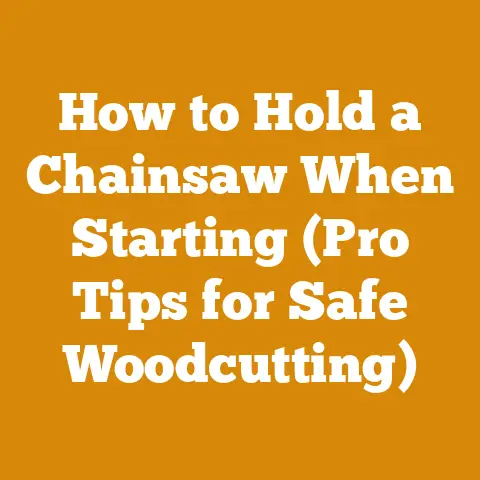How to Measure for Chainsaw Chain (5 Pro Tips for Perfect Fit)
Let me tell you a story. It was back in ’98, and I was just starting out, green as the freshly cut oak I was trying to wrangle. I’d inherited my grandfather’s old chainsaw – a beast of a machine, but with a chain that was, shall we say, “past its prime.” I went to the local hardware store, confidently told the guy behind the counter I needed a “new chain,” and walked out with what I thought was the right one. You can guess what happened next: it was completely wrong. Too long, wrong pitch, wrong gauge – a total mess. I spent the next hour wrestling with the thing, nearly stripping the bar studs, before admitting defeat. That day, I learned a valuable lesson: measuring for a chainsaw chain isn’t just important; it’s essential. Now, after decades of felling trees, milling lumber, and stacking firewood, I’m here to share my hard-earned knowledge. I’ll guide you through the process with five pro tips, ensuring you get the perfect fit every time.
How to Measure for Chainsaw Chain (5 Pro Tips for Perfect Fit)
Why Getting the Right Chainsaw Chain Matters
Using the wrong chainsaw chain can lead to a whole host of problems, from inefficient cutting and increased wear and tear on your saw to outright dangerous situations. A chain that’s too loose can derail, causing potential injury. A chain with the wrong pitch or gauge won’t fit properly on the bar and sprocket, leading to damage and poor performance. The right chain, on the other hand, will improve cutting efficiency, extend the life of your saw, and, most importantly, keep you safe.
Key Chainsaw Chain Terminology
Before we dive into the measuring process, let’s define some key terms:
- Pitch: The distance between any three consecutive rivets on the chain, divided by two. It’s expressed in inches (e.g., 3/8″, .325″, .404″).
- Gauge: The thickness of the drive links (the part of the chain that fits into the groove of the bar) where they fit into the guide bar groove. It’s also expressed in inches (e.g., .050″, .058″, .063″).
- Drive Links: The small pieces of metal that protrude from the chain and fit into the groove of the guide bar.
- Bar Length: The length of the chainsaw bar, measured from where it exits the powerhead to the tip.
- Sprocket: The toothed wheel that drives the chain around the bar.
Pro Tip #1: Check Your Chainsaw’s Manual (The Easiest First Step)
Before you grab a measuring tape, consult your chainsaw’s manual. Most manuals will list the recommended chain pitch, gauge, and drive link count for your specific model. This is always the best place to start, as it eliminates guesswork.
My Experience: I always keep the manual for each of my chainsaws in a designated drawer in my workshop. It saves me so much time and effort when I need to replace parts or troubleshoot issues.
Pro Tip #2: Identify the Pitch
The pitch is the first crucial measurement. Here’s how to determine it:
- Locate Three Rivets: Find three consecutive rivets on your chain. These are the round metal pins that hold the chain segments together.
- Measure the Distance: Use a ruler or measuring tape to measure the distance between the first and third rivet. Make sure you’re measuring from the center of each rivet.
- Divide by Two: Divide the measurement you obtained in step 2 by two. This will give you the pitch.
Example: Let’s say the distance between the first and third rivet is 3/4 of an inch (0.75 inches). Dividing that by two gives you 0.375 inches, which is equivalent to 3/8″. So, your chain pitch is 3/8″.
Common Pitches: The most common chainsaw chain pitches are:
- 1/4″ (0.250″): Typically found on small electric chainsaws and some carving saws.
- .325″: A popular choice for mid-sized chainsaws used for general cutting and firewood preparation.
- 3/8″ (0.375″): Very common on a wide range of chainsaws, from homeowner models to professional logging saws.
- .404″: Typically used on large, professional-grade chainsaws for felling large trees.
Important Note: If you’re unsure about the pitch, it’s always better to err on the side of caution and consult a professional. Using the wrong pitch can damage your chainsaw.
Pro Tip #3: Determine the Gauge
The gauge refers to the thickness of the drive links. Here’s how to measure it:
- Locate a Drive Link: Identify one of the drive links on your chain. These are the small metal pieces that fit into the groove of the guide bar.
- Use a Gauge Measuring Tool (Recommended): The most accurate way to measure the gauge is with a gauge measuring tool. These tools are inexpensive and readily available at most hardware stores. Simply insert the drive link into the appropriate slot on the tool to determine the gauge.
- Use a Caliper (Alternative): If you don’t have a gauge measuring tool, you can use a caliper to measure the thickness of the drive link. Carefully measure the thickness of the drive link where it fits into the guide bar groove.
Common Gauges: The most common chainsaw chain gauges are:
- .043″ (1.1 mm): Found on some small electric chainsaws.
- .050″ (1.3 mm): A very common gauge for a wide range of chainsaws.
- .058″ (1.5 mm): Another common gauge, often found on mid-sized to larger chainsaws.
- .063″ (1.6 mm): Typically used on larger, more powerful chainsaws.
My Experience: I’ve found that investing in a dedicated gauge measuring tool is well worth the cost. It ensures accurate measurements and prevents costly mistakes. I personally use a Stihl gauge measuring tool, which has been reliable for years.
Why Gauge Matters: The gauge must match the width of the groove on your chainsaw bar. If the gauge is too small, the chain will be loose and can derail. If the gauge is too large, the chain won’t fit into the groove at all.
Pro Tip #4: Count the Drive Links
The number of drive links is crucial for ensuring the chain fits properly on your bar. Here’s how to count them:
- Remove the Chain: Carefully remove the chain from your chainsaw.
- Lay the Chain Flat: Lay the chain flat on a surface.
- Count Each Drive Link: Starting at one end, carefully count each drive link along the entire length of the chain. Make sure you don’t miss any.
Accuracy is Key: Double-check your count to ensure accuracy. An incorrect drive link count will result in a chain that’s either too long or too short.
My Experience: I always use a small marker to mark the first drive link I count. This helps me keep track and avoid getting lost in the counting process. I also recommend counting the drive links twice to be absolutely sure.
Dealing with Broken Chains: If your chain is broken, you may have lost some drive links. In this case, you’ll need to determine the correct number of drive links based on your bar length and the chain pitch and gauge. You can usually find this information in your chainsaw’s manual or by consulting a professional.
Pro Tip #5: Consider the Bar Length
While the bar length doesn’t directly determine the chain, it’s an important factor to consider. The bar length dictates the number of drive links required for the chain to fit properly.
- Measure the Bar: Measure the length of the chainsaw bar from where it exits the powerhead to the tip.
- Compare to Existing Chain: If you have the old chain, compare its length to the bar. The chain should be long enough to wrap around the bar completely, with a slight amount of slack.
Bar Length and Drive Links: The bar length and drive link count are directly related. A longer bar requires more drive links, while a shorter bar requires fewer.
Example: A 20-inch bar with a 3/8″ pitch and .050″ gauge might require 72 drive links. However, a 16-inch bar with the same pitch and gauge might only require 56 drive links.
My Experience: I keep a chart in my workshop that lists the recommended drive link counts for different bar lengths and chain pitches. This helps me quickly determine the correct number of drive links for any chainsaw.
Putting it All Together: A Step-by-Step Guide
Now that we’ve covered the individual measurements, let’s put it all together in a step-by-step guide:
- Consult Your Manual: Check your chainsaw’s manual for the recommended chain pitch, gauge, and drive link count.
- Determine the Pitch: Measure the distance between three consecutive rivets and divide by two.
- Determine the Gauge: Use a gauge measuring tool or caliper to measure the thickness of the drive links.
- Count the Drive Links: Carefully count the drive links on your old chain.
- Measure the Bar Length: Measure the length of the chainsaw bar.
- Compare Measurements: Compare your measurements to the specifications in your chainsaw’s manual or online resources.
- Purchase the Correct Chain: Purchase a new chain that matches the pitch, gauge, and drive link count of your old chain.
Common Mistakes to Avoid
- Assuming All Chains Are the Same: Chainsaw chains come in different pitches, gauges, and drive link counts. Don’t assume that all chains are interchangeable.
- Ignoring the Manual: Your chainsaw’s manual is a valuable resource. Don’t ignore it.
- Inaccurate Measurements: Take your time and ensure accurate measurements. An incorrect measurement can result in a chain that doesn’t fit properly.
- Forgetting to Check Bar Wear: Before installing a new chain, inspect your chainsaw bar for wear and tear. A worn bar can damage a new chain.
- Over-Tightening the Chain: Over-tightening the chain can cause it to break or derail. Adjust the chain tension according to the manufacturer’s recommendations.
Choosing the Right Type of Chain
Beyond pitch, gauge, and drive link count, you also need to consider the type of chain. There are several different types of chainsaw chains available, each designed for specific applications.
- Full Chisel Chains: These chains have square-cornered cutters that provide fast and efficient cutting. They are best suited for clean wood and experienced users.
- Semi-Chisel Chains: These chains have rounded cutters that are more durable and forgiving than full chisel chains. They are a good choice for general cutting and dirty wood.
- Low-Profile Chains: These chains have a smaller cutting profile that reduces kickback. They are a good choice for beginners and homeowners.
- Ripping Chains: These chains are designed for cutting wood along the grain. They have a different cutter geometry than cross-cutting chains.
My Recommendation: For general firewood preparation, I recommend using a semi-chisel chain. It’s durable, versatile, and relatively forgiving. For felling trees, I prefer a full chisel chain for its speed and efficiency, but only when working with clean wood and proper safety precautions.
Maintaining Your Chainsaw Chain
Proper maintenance is essential for extending the life of your chainsaw chain and ensuring safe operation. Here are some tips:
- Sharpen Regularly: Keep your chain sharp by sharpening it regularly. A dull chain is more likely to kick back and can also damage your chainsaw. I personally sharpen my chains after every two or three tanks of fuel.
- Lubricate Properly: Use a high-quality bar and chain oil to lubricate your chain. This will reduce friction and wear.
- Adjust Tension: Adjust the chain tension regularly to ensure it’s not too loose or too tight.
- Clean Regularly: Clean your chain regularly to remove dirt and debris.
- Store Properly: Store your chain in a dry place when not in use.
Sharpening Techniques: There are several different ways to sharpen a chainsaw chain, including using a file, a grinder, or an electric sharpener. I prefer using a file for its precision and portability. However, an electric sharpener can be a good option for sharpening multiple chains quickly.
Safety First: Always wear safety glasses and gloves when sharpening your chainsaw chain.
Case Study: Troubleshooting a Chain Fit Issue
I once had a client who was struggling to get his new chainsaw chain to fit properly. He had purchased a chain that he thought was the correct size, but it was either too long or too short, depending on how he adjusted the tension. After inspecting his chainsaw, I discovered that he had installed the wrong sprocket. The sprocket was designed for a different pitch chain, which was causing the chain to skip and not fit properly. I replaced the sprocket with the correct one, and the new chain fit perfectly.
Lesson Learned: Always double-check that all of your chainsaw components are compatible before installing a new chain.
Chainsaw Safety: A Critical Reminder
Using a chainsaw is inherently dangerous. Always follow these safety precautions:
- Wear Appropriate Safety Gear: Always wear safety glasses, hearing protection, gloves, chaps, and a helmet when operating a chainsaw.
- Read the Manual: Read and understand your chainsaw’s manual before using it.
- Inspect Your Chainsaw: Inspect your chainsaw before each use to ensure it’s in good working condition.
- Maintain a Safe Distance: Keep a safe distance from other people and obstacles when operating a chainsaw.
- Use Proper Cutting Techniques: Use proper cutting techniques to avoid kickback and other hazards.
- Never Cut Above Shoulder Height: Never cut above shoulder height, as this increases the risk of losing control of the chainsaw.
- Be Aware of Your Surroundings: Be aware of your surroundings and watch out for hazards such as falling branches and uneven terrain.
- Never Operate a Chainsaw When Tired or Under the Influence: Never operate a chainsaw when you are tired, under the influence of alcohol or drugs, or otherwise impaired.
Kickback: Kickback is a sudden and dangerous reaction that can occur when the tip of the chainsaw bar comes into contact with an object. Kickback can cause the chainsaw to jump back towards the operator, potentially causing serious injury. To avoid kickback, always use proper cutting techniques and be aware of your surroundings.
Conclusion: Mastering Chainsaw Chain Measurement
Measuring for a chainsaw chain doesn’t have to be a daunting task. By following these five pro tips, you can ensure you get the perfect fit every time. Remember to consult your manual, accurately measure the pitch and gauge, count the drive links, and consider the bar length. With a little practice and attention to detail, you’ll be able to confidently select the right chain for your chainsaw and keep it running smoothly for years to come. And remember, safety always comes first.
Next Steps: Putting Your Knowledge to Work
Now that you’ve learned how to measure for a chainsaw chain, it’s time to put your knowledge to work. Here are some next steps you can take:
- Inspect Your Chainsaw: Inspect your chainsaw to determine if it needs a new chain.
- Measure Your Old Chain: Measure your old chain to determine the pitch, gauge, and drive link count.
- Purchase a New Chain: Purchase a new chain that matches the specifications of your old chain.
- Install the New Chain: Install the new chain on your chainsaw, following the manufacturer’s instructions.
- Test the Chainsaw: Test the chainsaw to ensure the new chain is working properly.
And most importantly, get out there and put your chainsaw to good use – safely and efficiently! Whether you’re preparing firewood, felling trees, or milling lumber, the right chainsaw chain will make all the difference.






